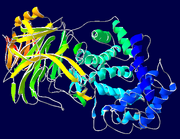1. Your patient is receiving 400 mg of dopamine in 500 ml of D5W for renal perfusion. The drug is infusing through an I.V. catheter in the cephalic vein of his left forearm. During your assessment, you note signs of extravasation. Which medication should be administered to treat this problem?
a. hyaluronidase (Wydase)
b. metoclopramide HCI (Reglan)
c. phentolamine (Regitine)
d. vincristine (Oncovin)
Rationale. c. Extravasation of a sympathomimetic drug such as dopamine should be treated within 12 hours by injecting 5 to 10 mg of phentolamine in 10 ml of 0.9% sodium chloride into the area of extravasation. Hyaluronidase is used for extravasation of hyperosmotic solution. Metoclopramide stimulates motility of the upper gastrointestinal tract without stimulating gastric, biliary, or pancreatic secretions. Vincristine is indicated for acute leukemia.
2. You have an order to infuse 1,000 ml of 5% dextrose in 0.9% sodium chloride solution over 8 hours. If the drip factor is 15 drops/ml, how many drops per minute will the patient receive?
a. 23
b. 31
c. 67
d. 125
Rationale. b.
total volume = ml/hour hours of infusion
1,000 ml = 125 ml/hour 8 hours= 125 ml/hour
ml/hour x drop factor = drops/minute 60 minutes
60 = 31 drops/minute 60
3. Which of the following symptoms should cause you to suspect that your patient has developed thrombophlebitis from his I.V. line?
a. a vein that is hard, sore, cordlike, and cool to the touch
b. itching, rash, and dyspnea
c. a red line following the vein proximal to the insertion site
d. swelling, pain, redness, and exudate at the site
Rationale. c. A red line following the vein proximal to the insertion site indicates thrombophlebitis. Other symptoms of thrombophlebitis include a vein that is hard, sore, cordlike, and warm to the touch; edema in the limb; and a sluggish flow rate. Itching, rash, and dyspnea indicate an allergic reaction. Swelling, pain, redness, and exudate at the site can indicate infection.
4. Which of the following helps prevent thrombophlebitis?
a. changing the I.V. container before it's completely empty
b. making sure that all I.V. medications are compatible
c. monitoring intake and output carefully
d. removing the needle and catheter together after an unsuccessful insertion attempt
Rationale. b. To help prevent thrombophlebitis, make sure that all of your patient's I.V. medications are compatible. Also, start I.V. lines in larger veins, tape the catheter securely, stabilize the catheter with a splint, dilute irritating additives, and make sure that the I.V. solution is infusing at the recommended rate. Changing the I.V. container before it's completely empty prevents an air embolism, carefully monitoring intake and output prevents circulatory overload, and removing the needle and catheter together after an unsuccessful insertion attempt prevents a catheter embolism.
5. Your patient requires a hypotonic I.V. solution to treat hypernatremia and dehydration. Which of the following IV. fluids will the physician order?
a. D^sub 5^ W
b. 5% dextrose in 0.9% sodium chloride
c. lactated Ringer's solution
d. 0.9% sodium chloride Rationale. a. The physician will order DsW, a hypotonic solution, which causes fluids to move intracellularly, rehydrating cells. Lactated Ringer's solution and 0.9% sodium chloride are isotonic solutions; 5% dextrose in 0.9% sodium chloride is a hypertonic solution.
6. The alarm on your patient's I.V. pump indicates "Occlusion, patient site." After assessing for any major I.V. therapy complications, you'd do which of the following to correct the problem?
a. Aspirate the contents of the catheter.
b. Discontinue the catheter.
c. Irrigate the catheter with 3 ml of heparin in a 10-units/ml solution.
d. Irrigate the catheter with 3 ml of 0.9% sodium chloride.
Rationale. a. First, aspirate the potential clot to prevent it from reaching the circulation. If you can't aspirate, you may need to discontinue the catheter. Don't irrigate the catheter with any solution; doing so may dislodge a clot at the tip of the catheter, causing it to enter the venous circulation.
7. Your patient has received two units of packed red blood cells. Because the units have been stored for 21 days, you should closely monitor your patient for an elevation in which of the following serum electrolytes?
a. calcium
b. chloride
c. potassium
d. sodium
Rationale. c. Blood that's been stored for 21 days has a plasma potassium content of 23 mEq/liter. The increase in potassium is caused by the destruction of the red blood cells. At the end of 21 days, approximately 20% to 30% of cells have been destroyed. As cells die, potassium enters the plasma and increases serum levels.
8. Your patient's physician has ordered a peripherally inserted central catheter (PICC) for I.V. antibiotic therapy. Which of the following is a possible complication of inserting this catheter?
a. catheter embolism
b. hemothorax
c. cardiac tamponade
d. pneumothorax
Rationale. a. As with any peripheral catheter insertion, catheter shearing can cause a catheter embolism. However, PICCs don't carry the same insertion complications (such as pneumothorax, hemothorax, hydrothorax, and cardiac tamponade) as do regular central venous catheters. This is because of the catheter's peripheral insertion site.
BY GAIL A. BATORY-GRIFFITH, RN, MSN Nursing Instructor College of Nursing
University of Tennessee, Knoxville Knoxville, Tenn.
Copyright Springhouse Corporation Aug 1996
Provided by ProQuest Information and Learning Company. All rights Reserved



